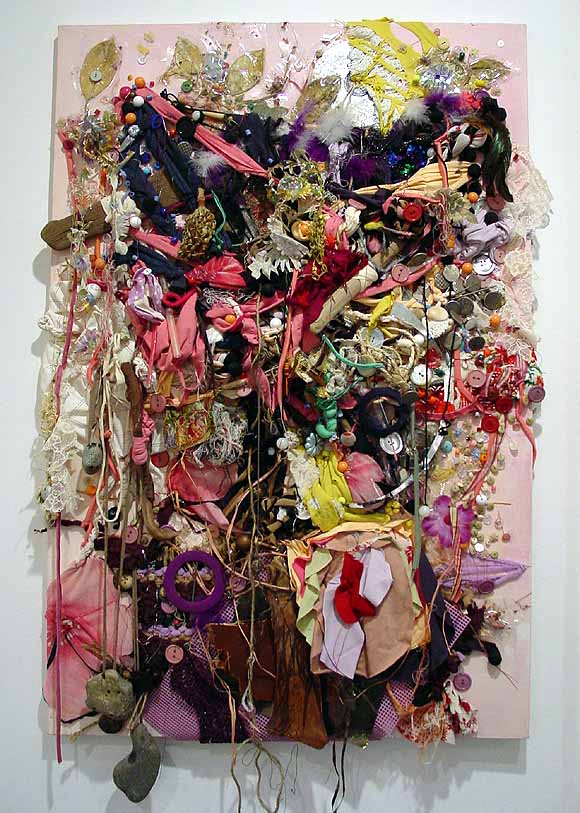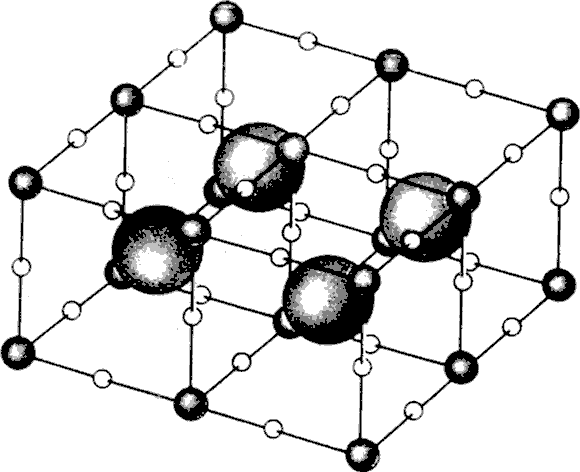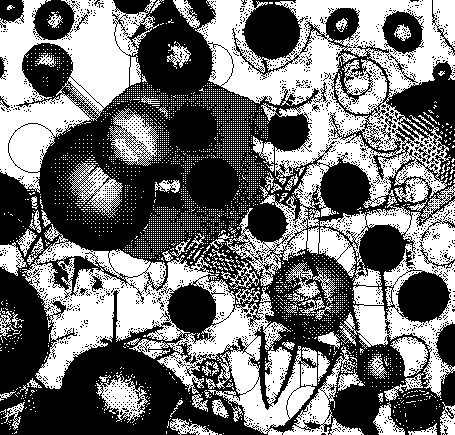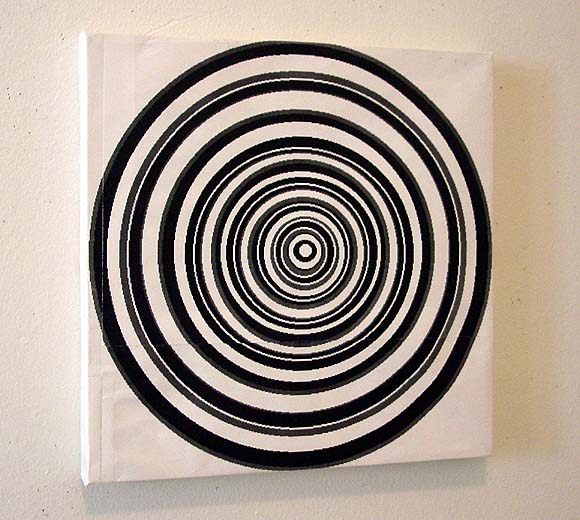View current page
...more recent posts

Another work from Leif Ritchey's show at ATM. In the beginning was Pollock, and it was called "formalism," but yea that was ridiculous because everyone knew it was a wrenching experience beyond language and not some pedantic exploration of art's technical building blocks. Then Pollock begat Mike Kelley, who stole from women (in a good way) and imbued the formal language that was never formal with specific cultural referents: the soiled stuffed animals plucked from a thousand swap meets that were tokens of love and personal debt: "more love hours than could ever be repaid." And they were good. And Pollock and Kelley begat Leif Ritchey, who returned art to its own innate discourse, leaving it to the viewer to find strands of narrative meaning in his seamstress bricabrac accumulated, teased, and tortured almost beyond belief. And thence it was bequeathed to cyberspace...

Drawings of piezoelectrically stimulated barium titanate from Scientific American, June 1988, animated without permission.
Artist Bill Schwarz, who has a page here at Digital Media Tree, got into a cool online food fight yesterday with "design sponge"--a design blogger recently profiled in the New York Times. What is a "design blogger"? Reporter Lockhart Steele gives the flavor:
On design blogs, readers who are normally not privy to chatter among interior decorators and tastemakers can participate in debates on burning topics (sample: Is the designer Karim Rashid overrated?); get advance word on design trends, like erotic stained glass; and find answers to practical issues, such as how to quiet an obnoxiously loud apartment buzzer. These tips and tidbits are sometimes dispensed by bloggers who support themselves with day jobs within the design industry.it seems Design Sponge blogs enthusiastically about (among other things) products her boss, a PR company, also happens to be flacking. Steele or his editor erroneously reported that she doesn't disclose the relationship--apparently she does, if that makes you feel better about her online recommendations.* Crabby artist that he is, though, Schwarz questioned the feelgood aspect of the project, from his own perspective as a former industry insider:
i think what puts me off about design sponge is the unironic career driven fashion immersion vibe. i worked for bergdorfs for over ten years and got a pretty good inside look at the design and fashion world. but it left me with fashion damage. what puts me off most is the underpinning of planned obsolescence. that little something that makes people dump their two year old stuff for new stuff. i think we should be dealing with classic designs that last for the life of the product and a product that is well made (a harris tweed jacket for instance) should last close to the life time of its owner.The wordy, wordy responses to Schwarz from design sponge and a rabid reader never replied to this issue. The rabid reader focused with Clarence Darrow-like intensity on Schwarz's use of the word "smarmy" to describe Design Sponge (I'd just say "gushy"), whether he learned of Design Sponge from the Times or on his own, and whether his comment was design blog jealousy. Pretty hard for the latter to be the case when you're running an art blog consisting mostly of minimally or cryptically worded links, with a recurring focus on design, architecture, and arcane Americana, I'd say, but anything's possible.
*Sermon-in-a-footnote. We've heard a lot of blather on the political blogs lately about the need for a blogger code of ethics. You write on blogs about what you know and what you feel passionately about, which may just happen to include carefully insinuated strands of paid PR flackery. Readers have to be critical too, and know that a blog may be good for information or inspiration but not necessarily hard, peer-reviewed facts. When I was reBlogging at Eyebeam, I was a hair's breadth from posting a picture of a "street tagger"'s work before I realized he was a well-paid-by-the-industry, footwear-decorating hack. At least one other hoax I didn't catch. Trust nothing!

From daily Kos:
U.S. Encouraged by Vietnam Vote :
Officials Cite 83% Turnout Despite Vietcong Terror
by Peter Grose, Special to the New York Times, September 4, 1967
WASHINGTON, Sept. 3-- United States officials were surprised and heartened today at the size of turnout in South Vietnam's presidential election despite a Vietcong terrorist campaign to disrupt the voting.
According to reports from Saigon, 83 per cent of the 5.85 million registered voters cast their ballots yesterday. Many of them risked reprisals threatened by the Vietcong.
The size of the popular vote and the inability of the Vietcong to destroy the election machinery were the two salient facts in a preliminary assessment of the nation election based on the incomplete returns reaching here.
This interview with a comment spammer should be of interest to bloggers dealing with this online pestilence. In a nutshell, comment spam is legal but unscrupulous use of blogs' comment features to game search engines and drive up traffic to various vice and pharm-oriented websites.
["Sam"] uses the thousands of "open proxies" on the net. These are machines which, by accident (read: clueless sysadmins) or design (read: clueless managers) are set up so that anyone, anywhere, can access another website through them. Usually intended for internal use, so a company only needs one machine facing the net, they're actually hard to lock down completely. Sam's code gets hundreds of open proxies to obediently spam blogs and other sites with the messages he wants posted. They usually target comments to old posts, so they won't show up to people reading the latest ones, though search engine spiders will spot them and index them.The only foolproof solution (or at least the only solution "Sam" admits he dreads) is to install "captchas" on your site, such as randomly generated letters mangled in an imaging program that are readable by humans but not spambots, which would have to be typed in at the start of each comment.

Disc, 1999, ink, paper, linen tape, wood, 10" x 10"
Truth in advertising: what the back of a similar piece looks like.
"72%" Iraqi Turnout Figure Already Plunging
Reuters:
BAGHDAD, Jan 30 (Reuters) - Iraq's Electoral Commission backtracked on earlier estimates of voter turnout in the election, saying a previous figure of 72 percent "was just an estimate" and indicated the actual figure was lower.Whatever the final number ends up being, you can be sure the Bush Media will keep saying 72% ("More than in the US election! Incredible! Aren't we great?"). More words from wet blanket Juan Cole:
At a news conference, commission spokesman Farid Ayar called the 72 percent figure a "guess" and said maybe up to 8 million Iraqis voted, which would be a little over 60 percent of registered voters.
"Percentages and numbers come only after counting and will be announced when it's over ... It's too soon to say that those were the official numbers," he said. "The numbers are only guessing."
The Iraqis did not know the names of the candidates for whom they were supposedly voting. What kind of an election is anonymous! There were even some angry politicians late last week who found out they had been included on lists without their permission. (This is the part of the process that I called a "joke," and I stand by that.)ABC is reporting 44 people killed on election day. Bush, Rice, Rumsfeld, Cheney: great work. You can also count that they'll say the "high" turnout was an after-the-fact justification for the invasion, now that the other justifications have evaporated.
This thing was more like a referendum than an election. It was a referendum on which major party list associated with which major leader would lead parliament.
Many of the voters came out to cast their ballots in the belief that it was the only way to regain enough sovereignty to get American troops back out of their country. The new parliament is unlikely to make such a demand immediately, because its members will be afraid of being killed by the Baath military. One fears a certain amount of resentment among the electorate when this reticence becomes clear.
Iraq now faces many key issues that could tear the country apart, from the issues of Kirkuk and Mosul to that of religious law. James Zogby on Wolf Blitzer wisely warned the US public against another "Mission Accomplished" moment. Things may gradually get better, but this flawed "election" isn't a Mardi Gras for Americans and they'll regret it if that is the way they treat it.
UPDATE: Good post runs down Bush's history of resisting the cleric Ali Sistani's call for this election and gives Sistani, not Bush, credit for the Shiite turnout today. Bush is getting his sound and image bites but is working behind the scenes to keep a religious figure from running Iraq.
UPDATE 2: From Robert Fisk in Iraq, by way of James Wolcott: "The big television networks have been given a list of five polling stations where they will be 'allowed' to film. Close inspection of the list shows that four of the five are in Shia Muslim areas 'where the polling will probably be high' and one in an upmarket Sunni area where it will be moderate. Every working class Sunni polling station will be out of bounds to the press. I wonder if the television lads will tell us that today when they show voters 'flocking' to the polls."
